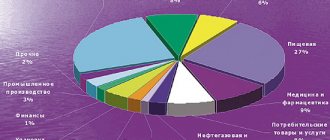Long-term investments are investments of funds for a period of 1 to 5 years.
The concept covers a wide range of possibilities. Both securities (shares and debt obligations) and construction and purchase of real estate are used.
The key feature of long-term projects versus shorter time periods is a relatively high level of stability. Short-term intervals on financial markets and short economic downturns do not have any strong impact.
Long-term investing: types and opportunities
Today, long-term investments are divided into separate classifications according to investment objects.
In particular, for real investments and long-term financial investments.
Financial investments include: provision of loans, as well as the purchase of securities. The main objective of such investments is to generate additional income.
As for real long-term investments, they represent significant investments in various areas of production, in particular:
- Acquisition of real estate.
- Allocation of funds for the construction of new production facilities.
- Purchasing new and updating outdated equipment.
- Purchase of land and funds.
- Improvement of the company's key assets.
- Acquisition of real estate;
- Obtaining user rights and trademarks.
- Allocation of funds to the development of new technologies.
The profit received as a result of successful long-term investment is a collection of steadily incoming cash, which ultimately pays for the project and then makes a profit.
It is worth noting the fact that this type of investment does not bring immediate and fleeting profits in the short term. In most cases, it is evenly distributed in the allotted time interval.
For example, a private investor decided to invest in housing in one of the prestigious areas of the city.
Having invested, for example, 5 million rubles in the purchase, he will be able to sell the building in a few years at a price of 10 million rubles.
Given that the real estate market will grow and the economy is not in recession. Also, throughout the entire period of ownership of this housing stock, the investor can receive additional profit by renting it out. Thus, the profit could be about 15 million rubles.
Kinds
Financiers pout from the realization of their own importance - this is how much time it takes to remember super-intricate classifications.
I suggest forgetting the educational categories, since it all comes down to 2 areas: in the long term, an investor can become either an owner (buying, for example, antiques, land or an apartment) or a lender (investing in bank deposits, buying bonds, i.e. lending company).
When an investment is essentially a loan, interest is paid for the use of the funds, and at the end of the period the initial amount of the invested funds is returned (repaid). When invested capital turns the owner of finance into an owner, you can count on interest income or profit from business activities (you bought a company, you rent out real estate).
Prospects
Throughout the existence of the capital market, profit-making tools have been improved. There are many investment opportunities available today, from real estate to the venture capital and derivatives markets.
However, only a few main areas remain consistently popular among investors, funds and banks. The reason for this is the low level of risk and high level of profitability.
Top brokerage companies
My friends, knowing everyone’s laziness, I provide a list of working brokerage companies. But my advice remains valid: “if you are going to part with money, double-check the information yourself.”
Opening of Promsvyaz by Rick BKS Keith Tinkoff Finam
One of the mastodons of the market. Excellent web portal, very low commissions and adequate support. I recommend!
Investment department of a famous bank. There are no particular advantages, but there are no disadvantages either. Average.
One of the very first Russian brokers. The commissions are high, but there are interesting auto-following strategies.
Another very large broker. Good support and low commissions are their strong point.
Small but reliable broker. It is great for beginners because it does not impose its services and the commissions are very low. I recommend.
The youngest broker in the Russian Federation. There is a cool app for investors, but the fees are too high.
The largest investment company in Russia. The largest selection of tools, your own terminal. Commissions are average.
Purchase of securities
The basic principle of working with securities is based on buying at a low cost and selling at a higher cost.
The most popular among them are:
- Ordinary shares.
- Debt obligations (bonds).
- Preference shares.
Each of the three types of securities listed above has certain characteristics and is purchased for various reasons. For example, with long-term investments in shares, as mentioned above, there is an expectation of resale at a higher price.
In other words, by buying Sberbank shares for 65.00 rubles and selling them for 100 rubles, you can make a profit of 35 rubles for each share purchased. Taking into account the high liquidity of this security, its sale on the stock market will not be difficult.
Preferred shares are purchased primarily to receive dividends. The difference with ordinary shares is the right of ownership; the owner of a preferred share has a 100 percent opportunity to receive dividends, while the owner of an ordinary share may be left without such payments. However, in the event of a company bankruptcy, the holders of common stock have first rights of ownership.
The relationship between risk and return in the securities investment market
When purchasing debt securities, an investor expects to receive a stable monthly or annual interest payment. By purchasing bonds with a maturity of 5 years, the investor receives successive payments averaging a few percent.
Also, it is worth noting that no matter how profitable the investment opportunity may seem, you cannot invest in one single asset. The same applies to the purchase of securities. It is important to qualitatively diversify the investment portfolio, which would correspond to an acceptable level of risk and profit.
Strategic investments are considered to be the purchase of a large number of shares. In other words, to establish complete control over the enterprise. To gain control over a company, it is enough to have 50 percent plus 1 share in the portfolio.
In most cases, the process of acquiring a controlling stake takes the investor quite a long time.
Accounting for long-term investments
A transparent scheme for managing waste and profits will allow your partners to assess the real prospects. As a rule, this work is left in the hands of independent experts to obtain objective results. Accounting for investments in fixed assets or even attracting non-monetary funds (advice, training, property rights) requires recording in documents or programs. The balance account for this is 08.
As a rule, one of 2 popular strategies is chosen:
- At the start, equity participations are indicated, any waste operation (repairs, modernization, salary payments, etc.) is constantly methodically recorded, and when calculating profits, calculations are made using a percentage (share) ratio.
- All expenses and all pluses for a certain period are considered a package, and when dividing profits, the share of investments is also taken into account.
Both strategies are combined by the method of calculating profit, but in order to get it, you should still adhere to a number of simple rules.
Construction and real estate investment
At all times, no less attractive was investing money in construction, as well as the purchase of real estate, in particular:
- acquisition of finished residential premises;
- commercial and industrial buildings.
Under Russian legislation, the use of credit funds to finance construction is quite acceptable.
However, you should always remember the possible level of risk, and therefore it is imperative to calculate all future risks, including bankruptcy of the contractor.
Losses are possible when investing in already completed construction. In particular, for downtime of premises that are designated for rent. On the other hand, the real estate market can bring considerable profits in the case of a growing economy, as well as increased income and spending of the population.
Tips on how to make money on long-term investments
If you decide to get serious about long-term investing, look through B. Graham’s book “The Intelligent Investor.” The market is unpredictable, but you can learn to make a profit from any afterburner:
- It is wise to purchase shares of companies whose production and sales rates are higher than the industry average. Pay attention to positive cash flow and working capital reserves.
- When choosing an investment object, stop at 2–3. This makes it easier to control the situation.
- The purchase price is favorable if the price of the shares is lower than the market value of the company (margin of safety concept).
- Write a rationale: why this investment is attractive. If words are not enough, emotions have taken over, which means this is an investment with increased risk.
- It is worth purchasing real estate in an area (city, country) that you know well.
- Precious metals sold by one bank may not be accepted by another. Please check this point before purchasing.
- It is profitable to buy precious stones on the secondary market (only with a specialist!).
Efficiency calculations
Calculation of investment efficiency is based on the results of a preliminary audit using financial ratios. Using financial ratios, you can obtain the following data:
- Profitability.
- Liquidity (solvency).
- Asset turnover.
- Market sustainability.
- Financial stability.
- State of fixed assets and their reproduction.
For each type of investment project, specialized long-term investment coverage ratios are selected. True, before using the multiplier, and certainly before making a decision, it is important to determine the net value of the investment project under study in which funds will be invested, or in other words, determine the NPV.
This indicator shows the difference between cash receipts and expenses, adjusted to “today’s time.” In other words, it shows the amount of money that an investor can earn from a project after the cash flows fully recoup its initial costs.
As a rule, if the NVP indicator is greater than zero, then you can invest in the project, but if the indicator is below zero, then it is worth abandoning the investment.
NVP calculation example
The investment amount is 115,000 rubles.
- Investment income for the first year – 32 thousand rubles.
- In the second year - 41 thousand rubles.
- In the third year - 43,750 rubles.
- For the fourth year - 38,250 rubles.
The discount rate is 9.2 percent.
Let's convert future cash flows into current values:
PV1 = 32000 / (1 + 0.092) = 29304.03 rubles.
PV2 = 41000 / (1 + 0.092)2 = 34382.59 rubles.
PV3 = 43750 / (1 + 0.092)3 = 33597.75 rubles.
PV4 = 38250 / (1 + 0.092)4 = 26899.29 rubles.
Net present value = (29304.03 + 34382.59 + 33597.75 + 26899.29) – 11,5000 = 9183.66 rubles.
Result: NPV is equal to 9183.66 rubles.
Precious metals are a very profitable way to invest money. Cash investment in gold can be called a win-win option. Read more about investment instruments.
Read here where to start looking for an investor for your company.
And here https://businessmonster.ru/gde-vzyat-dengi/kredityi/kreditovanie-malogo-biznesa-s-nulya.html you will learn about whether it is worth taking out a loan for a business from scratch if you do not have start-up capital. The nuances of obtaining such a loan.
Step-by-step instructions: how to invest in long-term assets
Investing is a risky process, but it has nothing in common with gambling. If advised:
- Buy shares of a company on the verge of bankruptcy - there are always people who want to grab production for nothing.
- Invest in real estate on the outskirts - look at the area first.
- Invest in the production of a hypernavel, a flight to Mars, breeding especially valuable amoebas - take a break.
It is better to invest capital in something less bright and, at first glance, not so profitable, than to give money to a rogue.
Selection of investment objects
The first step is to determine the amount for long-term investment. If funds are small, the choice is simple:
- deposits, shares, bonds;
- mutual, stock and other investment funds;
- real estate;
- precious metals;
- art, wine and other exotic items.
Before you buy (invest), determine how much you are willing to lose:
- 5% – government securities funds are suitable;
- 10% – bond funds;
- 20% – mixed investment funds;
- 30% – interval, sectoral, index funds;
- More than 30% are open-ended equity funds.
Collection of information on investment objects
When you figure out the direction of long-term investments, you will have to collect as complete a dossier as possible. If these are shares of an enterprise - public reporting, reputation of management, history of the enterprise. Any little thing, right down to the equipment of the early 18th century. and broken showers for workers.
Insider information is also important: who is whose son is in the leadership, who has a “furry” paw in the government. All this will give the most complete picture: the company is preparing for bankruptcy (they are going to leave the borrowers with nothing) or there is development.
Asset acquisition
Securities listed on stock exchanges are now available to anyone through a broker trading on that exchange. You enter into an agreement, transfer funds for the purchase and commissions.
There is no possibility - intermediaries (subbrokers) offer their purchasing services. There are also online brokers, where a computer application helps you buy securities.
An easier option is to contact investment funds (open, closed, interval).
Market monitoring and investment portfolio viewing
The most exciting thing after the acquisition is monitoring the situation. After all, the investment is long-term, if inflation shoots up, you will have to make a fundamental decision (bury your head in the sand and hope, or quickly sell it at a loss).
The rule is the same: calm and analysis. When you regularly review the reports, you understand the artificiality of panic.
Sources of financing
The key source of financing long-term investment projects is the company's own capital.
It includes:
- sinking fund;
- profit;
- off-budget funds.
At the same time, we should not forget about such a phenomenon as intangible investments, which is necessary for the implementation and expansion of the company’s scientific potential.
As for attracting credit funds for investments, they are valid only if their participation is appropriate. A careful assessment of the potential risks of a long-term investment, as well as the net level of return, must be made.
Sources of financing for long-term investment projects are divided into own funds and borrowed funds. The difference is based on the fact that the company’s personal money is primarily its income, which remains with the company after all taxes have been paid and insurance compensation has been made.
Financial statements
A private person who has purchased several shares does not engage in accounting reporting. But this rule does not exempt you from paying taxes. Funds and banks withhold the required amount automatically.
If the long-term investment is residential or commercial real estate, it is better to consult with a lawyer and enter into a formal agreement before leasing.
Enterprises engaged in investments in addition to their main activities keep records and display cash flows based on accounting standards.
Investment method No. 2. Purchase and sale of treasury shares in the company
There are two types of repurchase of shares in a company: cash-in and cash-out.
Cash-in is when money from the sale of a share goes to the company (goes towards its development). Cash-out is when the money from the sale of a share falls into the hands of the participant who sold it and does not go to the development of the company. Selling a stake in a company using the cash-out model can hardly be called an investment; rather, it is a way for a project participant to return investments. Since the point of investments is that they go towards business development, it only makes sense to talk here about selling a share using the cash-in model. The purchase and sale of shares according to this model is possible when the so-called “treasury share” is sold, the owner of which is the company itself (LLC).
By law, the treasury share can belong to the company for no longer than one year. During this time, it must either be distributed among the company's participants in proportion to their shares, or repaid (by proportionately reducing the authorized capital), or sold to some person.
The purchase and sale of a treasury share is ideal for establishing cash-in investments, since in the transaction the buyer is the investor, and the seller is the company itself. Thus, the proceeds from the sale of the treasury share go to the company and go towards its development.
Of course, companies do not always have a treasury share at their disposal, which makes it much more difficult to use this method of making investments. However, a treasury share can be obtained “artificially” by bringing in and out of the company some friendly person. Of course, this manipulation is fraught with some corporate and legal risks, but it does not contradict the law and, with the proper skill of the accompanying lawyers, will not entail any negative legal consequences.
Investment method No. 5. Loan
Some people consider borrowing a type of investment (which is why I included it in the list of investment methods).
Although, in my opinion, a loan is not an independent way of investing, because for me an investor is a person interested in developing a business (increasing the value of the company), and not just in returning and increasing invested funds. In other words, if a person provides financing but does not acquire a share in the company, then this is not an investor, but a creditor, lender, interest-bearer. But as soon as the lender (interest-bearer) acquires a stake in the company, he becomes an investor. The difference is that a pawnbroker, in order to protect his “investments,” can much more easily take extreme measures, up to and including initiating bankruptcy of the company, when, as an investor, protecting his investments, he will, first of all, contribute to the development of the company and the growth of its value. Moreover, owning a share in a company implies not only rights, but also responsibilities (remember at least the investment method No. 3 I cited). In the case of a loan, the investor’s interest lies only in returning the funds and receiving interest, and he is not particularly interested in the source of the money itself (repayment of the debt and payment of interest here can be ensured through on-lending, for example).
At the same time, adding funds to a project in the form of a loan can be used as an addition to investment methods No. 1 or No. 2. In this case, the investor distributes risks by combining methods of financing the project.
Step-by-step investment process
Having decided to choose one of the listed directions, you should prepare well. “Measure twice, cut once” - this rule works perfectly when it comes to investments. A preliminary risk assessment and development of an investment plan will allow the investor to protect himself from failure. To invest more productively, you can divide the process into stages.
- Selection - at the first stage, different investment options are evaluated. It is important to set goals that you plan to achieve. This could be buying a home, a car, going on vacation or other requests. Each goal is tied to the term of the long-term investment. Options suitable for achieving the result are selected.
- Data collection - each investment area identified at the first stage is analyzed. Potential profitability is assessed, risks are identified and compared. Analysis of large projects is carried out by lawyers and financiers. The first will be able to assess the legality of the enterprise and legal risks. Financial specialists will calculate the prospects of the project and economic risks.
- Choice - after a deep analysis of all directions, the most profitable and least dangerous is selected. The selected assets must have a good level of profitability and contribute to achieving the goal. It is important to divide your investments by investing them in different financial assets. Even if one of the projects brings losses, a profitable direction will equalize the situation.
- Investments - when investing money, the main goal is the preservation of capital and its stable growth. Smart investments are made at the most favorable moment, for example, during a crisis situation or a seasonal market decline. Since prices are lower at such times, the investor maximizes profits.
- Monitoring - having made investments, it is important not to forget them and regularly study the market. Each goal should be broken down into intermediate stages, and over time the investment should achieve them. Market behavior can be unpredictable, so if there is no control, capital will burn. An investor should always be aware of the state of his investments in order to exit the project in time or change the amount of participation in it.
Long-term investing involves the investor risking a significant amount. Responsibility for decisions lies solely with the investor, and a competent plan is required from him.
Investments without losses are impossible because investments cannot only bring profit. The skill of an investor lies in the ability to compensate for losses with profits and not lose heart when the investment of funds is unsuccessful.











